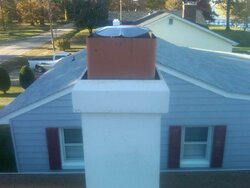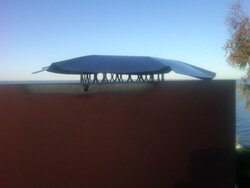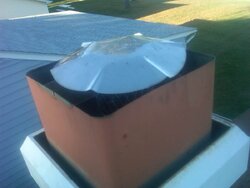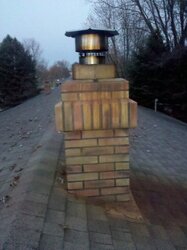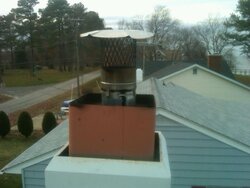So I thought I had successfully installed a wood insert into a ZC fireplace/chimney, with a 6" (inside of 9") liner. I stuffed the bottom with fiberglass insulation (a blockoff plate was very difficult given the geometry of the chimney--I tried) and poured in perlite through the top. OK, no leaks. Until I fired the stove a couple of times. Then a few pellets would fall behind the insert as the chimney heated, and would stop. Well, on the third night, the pellets kept leaking. Looks like the expanding/compressing of the chimney ground the "course" pellets into much finer stuff. Anyway, over a period of a minute or so, about 1/2 - 3/4 of the insulation leaked down behind the insert, while I had a fairly good fire going. I was peaved, but not overly concerned, as the only space was between the new insert and the walls of the old fireplace. Very soon afterwards however, smoke started billowing into the living room. I was able to remove the burning wood outside and evacuate the family (thankfully we were all sitting there when it happened), but it freaked me out. I have no idea what happened. The chimney appears intact, and is connected securely to the insert. None of the perlite made it anywhere that I would think should impact the fire. When I open the door when cold, I can feel a good draft up the chimney. Everything looked as it was on the roof. It didn't appear that there was smoke infiltration into the gap around the lining. During/immediately after the incident I went to the attic and put a hand on the outer fall of the chimney, which was just warm--nothing out of the ordinary. So today, I cleaned the perlite from around the insert and started a small fire. So far so good. Went on the roof. All well. Made a smokey fire. No problem. Made a big, hot fire. Everything was fine. I kept a watch behind the insert during this time, and didn't see any smoke at all. So. While I'm glad I can't find anything wrong, I don't like not knowing what happened. The only thing I can think of is that the rapid perlite movement caused a temp swing in the chimney that reversed the draft. But that's a WAG and I'm not at all convinced by this. The other thing is that I wasn't happy with the top of the chimney (pics attached). There is still free movement of smoke, but it seems confined, and I'm wondering if this contributed to my problem (why I didn't have a problem the other nights, and why it coincided with the perlite falling, I don't know).
1. What caused this?
2. What's my next step?
3. As far as the chimney, my choices are to either cut that red sheetmetal down 6" to leave the guard completely exposed, raise the guard 6" with some stovepipe, or...?
4. Can/should I reinsulate? I'm thinking for now, I should just put some rock wool or whatever in the top to seal the draft. The insulation was put in mainly for protection in a chimney fire--I don't think it's strictly necessary. Shoulda gone with the vermiculite, but they were sold out, and I thought the perlite would be equivalent. Also thought I had sealed the bottom pretty well. Guess not. I'm not going to remove the insert to try and reseal the bottom--the clearances were tight, and it took me hours to get it in.
1. What caused this?
2. What's my next step?
3. As far as the chimney, my choices are to either cut that red sheetmetal down 6" to leave the guard completely exposed, raise the guard 6" with some stovepipe, or...?
4. Can/should I reinsulate? I'm thinking for now, I should just put some rock wool or whatever in the top to seal the draft. The insulation was put in mainly for protection in a chimney fire--I don't think it's strictly necessary. Shoulda gone with the vermiculite, but they were sold out, and I thought the perlite would be equivalent. Also thought I had sealed the bottom pretty well. Guess not. I'm not going to remove the insert to try and reseal the bottom--the clearances were tight, and it took me hours to get it in.


